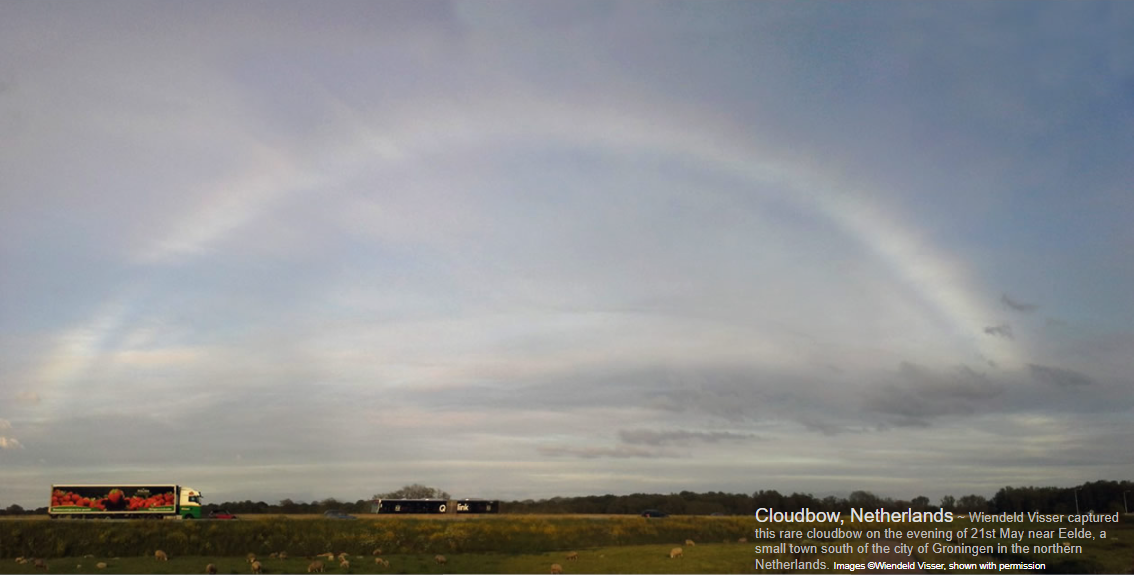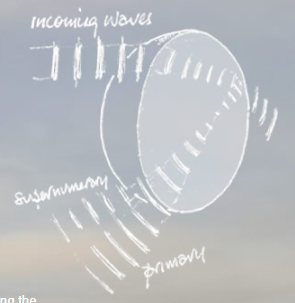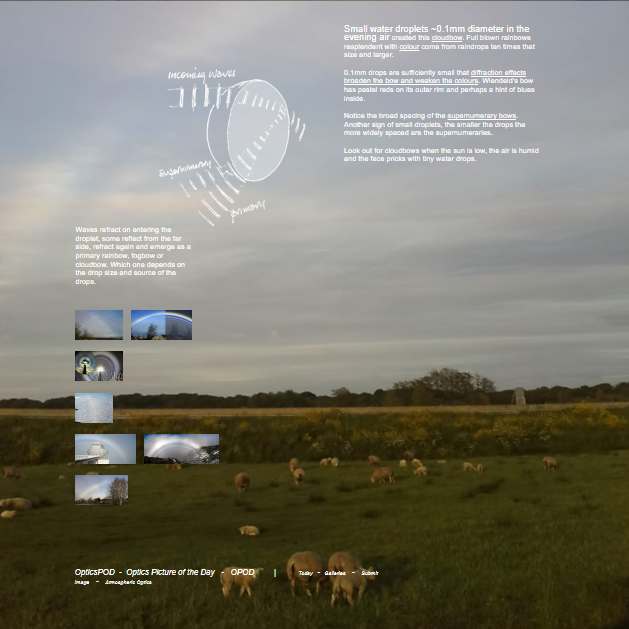Cloud Bow, Netherlands - OPOD
Cloud Bow, Netherlands - A Rare Atmospheric Phenomenon
The enchanting beauty of atmospheric optics never fails to mesmerize us. One such captivating sight is the cloudbow, a rare phenomenon that occurs when small water droplets in the evening air create a bow-like arc of colors in the sky. While full rainbows are formed by larger raindrops, cloudbows are born from tiny droplets, approximately 0.1mm in diameter.
Wiendeld Visser, a talented photographer, was fortunate enough to capture this elusive cloudbow on the evening of May 21st near Eelde, a small town south of Groningen in the northern Netherlands. The images he shared reveal a pastel display of reds along the outer rim of the bow, with hints of blues within.
Understanding Cloudbows
The delicate nature of cloudbows is due to the small size of the water droplets involved. These minute droplets, being one-tenth the size of raindrops, experience diffraction effects that broaden the bow and weaken the intensity of its colors. As a result, cloudbows often exhibit softer hues compared to their more vibrant and vivid counterparts.
Observing Wiendeld's cloudbow closely, one can notice another intriguing feature - the broad spacing of supernumerary bows. These additional faint rainbows, which appear parallel to the primary bow, are further indications of the presence of small droplets. The smaller the droplets, the wider the spacing between these supernumeraries.
Ideal Conditions for Cloudbow Formation
To witness the ethereal beauty of a cloudbow, certain atmospheric conditions must align. Here's what to look out for:
-
Low Sun: Cloudbows are most commonly observed when the sun is low on the horizon, either during sunrise or sunset. This positioning allows the sunlight to pass through a greater distance of the atmosphere, increasing the likelihood of interaction with water droplets.
-
Humidity: The air must be humid for cloudbows to form. This moisture-laden atmosphere provides the necessary water droplets required for the phenomenon to occur.
-
Tiny Water Droplets: Cloudbows are specifically created by small water droplets, approximately 0.1mm in diameter. These droplets, suspended in the air, serve as the canvas upon which the cloudbow paints its delicate hues.
The Science Behind Cloudbow Formation
Understanding the science behind cloudbow formation adds another layer of fascination to this atmospheric spectacle. When sunlight enters a water droplet, it refracts and undergoes internal reflection. Some of the light reflects from the far side of the droplet, refracts again, and emerges as a primary rainbow, fogbow, or cloudbow. The specific type of bow formed depends on both the size of the droplets and their source.
-
Primary Rainbow: When raindrops are larger than 0.1mm, they create the familiar primary rainbow with its vibrant colors and well-defined shape.
-
Fogbow: In foggy conditions, where droplets are smaller than raindrops but larger than those forming cloudbows, a fogbow may appear. Fogbows lack the colorful bands of a primary rainbow and instead exhibit a hazy, whitish appearance.
-
Cloudbow: Finally, when the air is saturated with tiny water droplets, as in the case of cloudbows, the diffraction and interference of light result in a soft, pastel-colored arc in the sky.
Appreciating the Beauty of Cloudbows
Cloudbows are a testament to the enchanting wonders of nature. Their delicate hues and ethereal presence evoke a sense of awe and wonder. As we gaze upon these ephemeral arcs of color, we are reminded of the intricate interplay between light, water, and atmosphere.
Capturing the beauty of cloudbows through photography, as Wiendeld Visser has done, allows us to cherish these fleeting moments and share them with others. It is through the lens of talented individuals that we can truly appreciate the extraordinary phenomena that grace our skies.
In conclusion, the cloudbow is a rare and captivating atmospheric phenomenon. Formed by small water droplets in the evening air, cloudbows display pastel colors and broad spacing of supernumerary bows. To witness this enchanting spectacle, keep an eye out for low sun, humid conditions, and tiny water droplets. Embrace the beauty of cloudbows and let them inspire a deeper appreciation for the wonders of our natural world.

Cloudbow, Netherlands ~ Wiendeld Visser captured this rare cloudbow on the evening of 21st May near Eelde, a small town south of the city of Groningen in the northern Netherlands. Images ©Wiendeld Visser, shown with permission

Small water droplets ~0.1mm diameter in the evening air created this cloudbow. Full blown rainbows resplendent with colour come from raindrops ten times that size and larger.
0.1mm drops are sufficiently small that diffraction effects broaden the bow and weaken the colours. Wiendeld’s bow has pastel reds on its outer rim and perhaps a hint of blues inside.
Notice the broad spacing of the supernumerary bows. Another sign of small droplets, the smaller the drops the more widely spaced are the supernumeraries.
Look out for cloudbows when the sun is low, the air is humid and the face pricks with tiny water drops.
Waves refract on entering the droplet, some reflect from the far side, refract again and emerge as a primary rainbow, fogbow or cloudbow. Which one depends on the drop size and source of the drops.

Note: this article has been automatically converted from the old site and may not appear as intended. You can find the original article here.
Reference Atmospheric Optics
If you use any of the definitions, information, or data presented on Atmospheric Optics, please copy the link or reference below to properly credit us as the reference source. Thank you!
-
<a href="https://atoptics.co.uk/blog/cloud-bow-netherlands-opod/">Cloud Bow, Netherlands - OPOD</a>
-
"Cloud Bow, Netherlands - OPOD". Atmospheric Optics. Accessed on November 26, 2024. https://atoptics.co.uk/blog/cloud-bow-netherlands-opod/.
-
"Cloud Bow, Netherlands - OPOD". Atmospheric Optics, https://atoptics.co.uk/blog/cloud-bow-netherlands-opod/. Accessed 26 November, 2024
-
Cloud Bow, Netherlands - OPOD. Atmospheric Optics. Retrieved from https://atoptics.co.uk/blog/cloud-bow-netherlands-opod/.